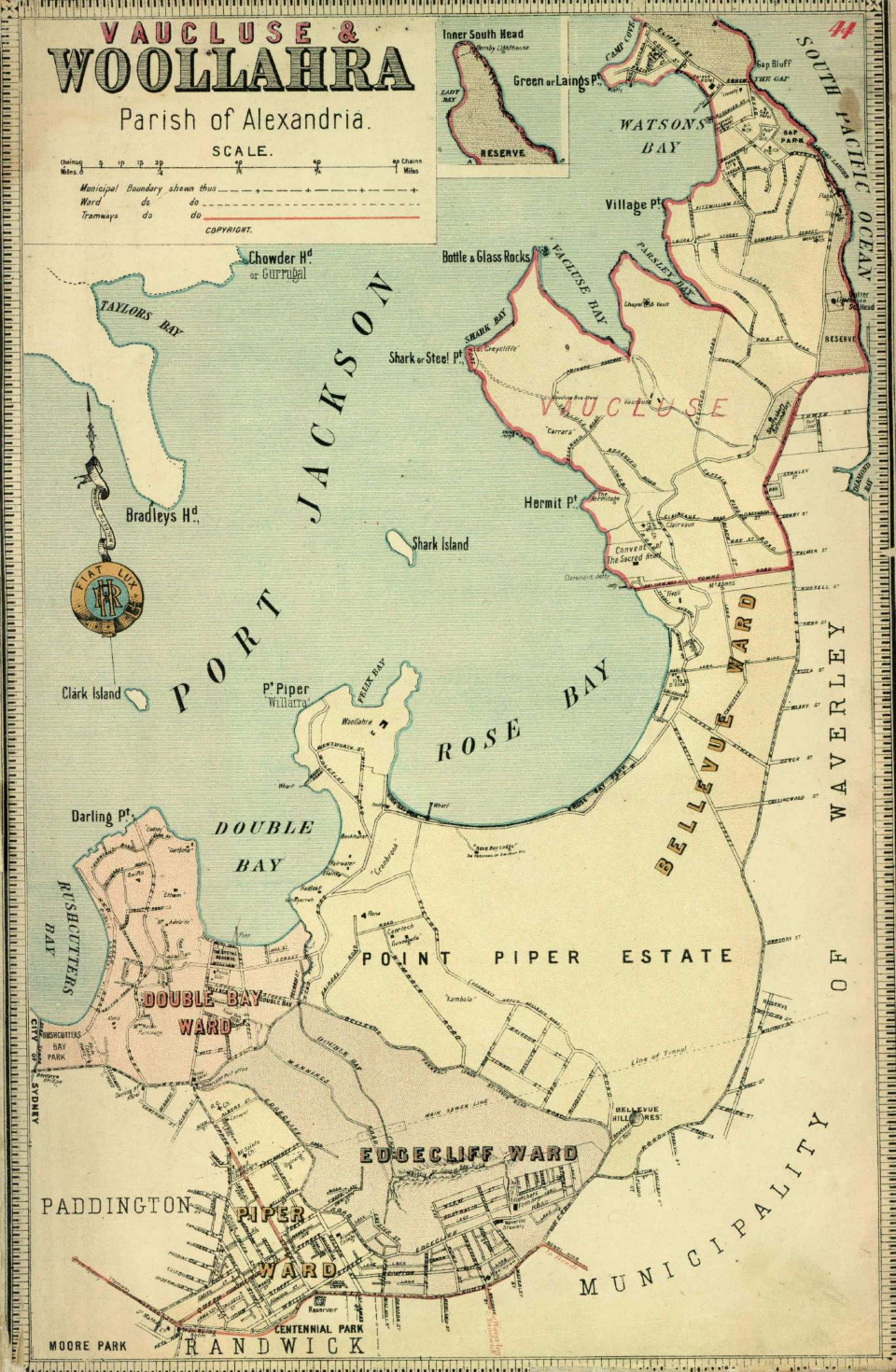The Dictionary of Sydney was archived in 2021.
Shark Island
Citation
Persistent URL for this entry
To cite this entry in text
To cite this entry in a Wikipedia footnote citation
To cite this entry as a Wikipedia External link
Shark Island
Shark Island [media]sits in Sydney Harbour, just one kilometre from Rose Bay. It is about 250 metres long and 100 metres wide, and its highest point is nearly 10 metres above sea level. It is an attractive and picturesque island of shady trees, sandstone grottoes, grassy slopes and small sandy beaches. It gets its name from the fact that its outline is vaguely similar to that of a shark. 'Boambilly' was its Aboriginal name.
[media]Shark Island has a fractured history as a place of outstanding beauty but also of great danger, to both swimmers and ships. During the nineteenth century, a number of shipwrecks and drownings occurred off the island and in 1890 a white navigation warning light was finally erected; in 1924 this was replaced by a flashing light. [1] During the 1830s the island served as a quarantine station to prevent the introduction of cholera to the colony following an outbreak in Europe. [2] Between 1871 and 1900 imported cattle and dogs were quarantined there. [3]
From quarantine to public park
Despite the obvious importance of quarantine stations for the health of the community, many Sydneysiders felt that the beautiful harbour islands belonged to the people and should be public spaces of rest and recreation. Conceding to the pressure of public opinion, the New South Wales Government restored the status of Shark Island as a public reserve in 1900; it opened again to the public in 1905. On hearing the news, the Amateur Fishermen's Association congratulated themselves for the part they had played. According to them,
For many years the Amateur Fishermen's Association has been hammering away to get this island as a landing place for the public, and it is satisfactory to think that at last their efforts will be crowned with success and the island thrown open to the public. It would not be a bad idea for the AFA to have a little gathering on the island shortly after it is thrown open, to celebrate the event. [4]
Over the next few years and under the guidance of the Clark Island Trust, many botanical and structural improvements were made to Shark Island with the intention of creating for the people of Sydney a truly Edwardian English picnic park. The Sydney Harbour Trust assumed control of the island in 1917 and made further improvements with the construction of new pathways and the addition of further garden seats and shelters. In 1975 Shark Island became part of the Sydney Harbour National Park, managed by the National Parks and Wildlife Service.
Shark Island can claim an important and distinctive place in the history of Australian sailing. It was the site of great public excitement on Boxing Day 1945 when the first Sydney to Hobart race was launched from its shore. Nine yachts participated in the inaugural race and according to The Sydney Morning Herald, 'Sydney has not seen a grander, prouder or more beautiful sisterhood of sail'. [5] The event certainly commanded considerable attention and captured the adoring crowds' attention; despite the participation of only nine yachts,
hundreds of small craft – some the craziest and flimsiest of sail-bearing canoes – followed the fleet through the Heads into the challenging surge of the ocean, but the start was smooth and untroubled and no ship, despite the crowds of eager, sight-seeing boatmen, lost an inch of paint! [6]
Shark Island remains a favourite spot where the people of Sydney can watch the start of this (now much larger) annual event. With views stretching towards the Harbour Bridge and the white sails of the Opera House in one direction, and over to Manly and the Heads in the other, Shark Island is quite possibly the most precious jewel in the crown of the harbour.
References
Mary Shelley Clark and Jack Clark, The Islands of Sydney Harbour, Kangaroo Press, Sydney, 2000
Notes
[1] Mary Shelley Clark and Jack Clark, The Islands of Sydney Harbour, Kangaroo Press, Sydney, 2000, p 178
[2] Historic Records of Australia, series 1, vol 17, pp 663–64
[3] New South Wales Government Gazette, 22 December 1871
[4] 'Fishing Resorts', Sunday Times, 29 October 1905, p 3
[5] The Sydney Morning Herald, 27 December 1945, p 4
[6] The Sydney Morning Herald, 27 December 1945, p 4
.




